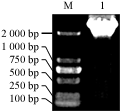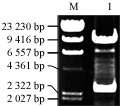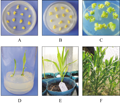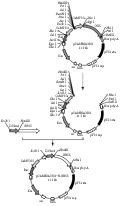Transformation of GBSS I Gene Driven with Barley Endosperm-specific Promoter into Maize Inbred Line Mediated by Agrobacterium 
 Author
Author  Correspondence author
Correspondence author
Maize Genomics and Genetics, 2012, Vol. 3, No. 1 doi: 10.5376/mgg.2012.03.0001
Received: 01 Dec., 2011 Accepted: 27 Dec., 2011 Published: 02 Jan., 2012
Zhou et al., 2012, Transformation of GBSS I Gene Driven with Barley Endosperm-Specific Promoter into Maize Inbred Line Mediated by Agrobacterium, Maize Genomics and Genetics, Vol.3, No.1, 1-5 (doi: 10.5376/mgg.2012.03.0001)
In present study, We made a plant expression construct that ligated GBSS I cloned from common wheat and endosperm specific promoter HorD from barley into pCAMBIA3301 by using the two bridge vector pGM-T-HorD and pGM-T-GBSSI , then the construct named pHorD-GBSSI was transformed into EHA105. Somatic embryogenesis of inbred line Y423 was used to be transformed by Agrobacterium tumefaciens mediation. Regenerated plants were harvested to be genetically detected and total of 35 palnrts were positive by PCR accreditation, accounting for 15% . We thought this study might provide a molecular way to improve the quality of maize starch.
Maize (Zea mays L.), one of the world's three major grain crops, is the most important forage crop and plays an important role in world food production. Starch is the main accumulation of maize grain material, which accounted for about 70% of grain weight in maize. Usually, the cornstarch is referring to the mixtures of amylose and amylopectin (Xia et al., 2011). Normal cornstarch contains about 28% amylase and 72% amylopectin. High amylose corn generally refers to the corn that the proportion of amylose content in the total corn starch reached more than 50% (Zhang et al., 2005). Amylose is an important industrial raw material and is widely used in food, medicine, chemical industry, papermaking, textile, architecture, petrochemical industry and plastics industries and other fields (Wang et al., 2002).
Granule-bound starch synthase I (GBSS I) gene, also called the waxy (Wx) gene, is a key enzyme of amylose synthesis. GBSS I specifically binds to the maize endosperm starch granules, thus it can maintain the synthesis amylose in an unbranched state. GBSS I is the only dynamic protein which can combine with the developing starch granule. Under the conditions of lacking branching enzyme, GBSS I only can synthesize linear glucan (Villand et al., 1992). With the antisense inhibition of expression of granule-bound starch synthase I (GBSS I ), potato plants with no amylose had been successfully obtained (Zhang et al., 2010). Utilization of antisense RNA technology, the expression of GBSSâ… gene can be specifically inhibited, and the GBSSI enzyme activity was reduced, which led the degradation of amylose content in plant starch (Visser et al., 1991). By analyzing the molecular biology and function of GBSS I gene in other crops, we came to the similar conclusion that the main function of GBSS I was responsible for the plant amylose synthesis (Chai et al., 2005). Barley hordein has a high polymorphism, the main function is to store protein, and it is synthesized in barley seeds. Experiment results show that barley hordein promoter HorD is a specific promoter for endosperm, it can be specifically expressed in the monocotyledon endosperm (Pistón et al., 2007).
In this paper, we attempted to construct GBSS I (granule bound starch synthase I), a key gene of wheat amylose synthesis, and HorD, a specific promoter for barley endosperm, into highly efficient plant expression vector. By over expression of wheat GBSS I gene, in specific stages, we found that this gene expressed massively in maize endosperm. And we used the somatic embryo subcultured around 20 d as the receptor to obtain a wheat GBSS I transgenic maize plants successfully by Agrobacterium mediated genetic transformation methods (Li, 2011).
1 Results and Analysis
1.1 Cloning of wheat GBSS I gene and barley endosperm specific promoter HorD gene
In this experiment, we designed the specific primers based on the wheat GBSS I gene sequence, and used wheat genomic DNA as template for PCR amplification. Then the recycling target bands were connected with pGM-T vector, which was transformed into E. coli DH5α, and the recombinant plasmid was sequenced. Comparison of sequencing results showed that the full length of the wheat GBSS I gene was 1 853 bp in size (Figure 1A); Based on the barley endosperm specific promoter HorD, we designed the specific primers. And barley genomic DNA was used as template for PCR amplification. Recycling target bands were obtained and connected to pGM-T vector, And then the vector was transformed into E. coli DH5α and sequenced. Compared to the sequence, the results showed that the full length of promoter HorD was 510 bp in size (Figure 1B).

Figure 1 GBSS I and HorD amplified from common wheat and barley, respectively
The plant expression vector was constructed successfully. And the result was validated by PCR and restriction enzyme digestion, and it was consistent with the expected result in size, which was 2 300 bp in size (Figure 2; Figure 3), which suggested that the vector pHorD-GBSS I be consistent with our experimental design.
 Figure 2 Plant expression vector pHorD-GBSS I was identified by PCR |
 Figure 3 Plant expression vector pHorD-GBSS I was identified by double enzymic digestion |
1.3 Agrobacterium mediated genetic transformation of maize
Somatic cell embryos subculture of about 20 d was transformed by Agrobacterium mediated method. The callus were cultivated in co-culture medium and in dark for 3 d at 25℃ after infection. Then they were transferred into bacteriostatic subculture medium for 10 d, and then were transferred into the inhibitory differentiation medium for differentiation. The results displayed that 113 regeneration plants were obtained after 45 d (Figure 4).
 Figure 4 Regeneration of transgenic maize plants |
1.4 Molecular detection of transgenic plant
Total DNA was extracted from the leaves of regeneration plant by CTAB method. Firstly, bar gene primers, which were designed previously, were used for PCR detection (Figure 5). There were 5 plants can amplify the same size electrophoretic bands with the target fragment, while the blank control and untransformed plants had no corresponding band. All the detected positive plants were handled with specific primers, which were designed with part of the promoter and gene fragment, for PCR detection, which also amplified the same bands as target fragment (Figure 6). These preliminary demonstrated that the target gene had been integrated into the regeneration maize plant, and the positive rate of which was about 15%.
Figure 5 Part of transgenic events detected by PCR for bar gene identification |
Figure 6 Part of the transgenic plants detected by PCR for targeted gene-specific fragments |
2 Discussion
In this research, we constructed a plant expression vector pHorD-GBSS I . We used barley endosperm specific expression promoter during this process, which has experienced GUS detection in callus and expressed successfully. There are some studies have shown that Hord gene has endosperm specific expression in transgenic plants (Cho et al., 1999). The purpose of this research is to make GBSS I gene over expressed in a specific period to improve the amylose content in maize endosperm. So far, the regeneration plant contain GBSS I gene regeneration plant has experienced PCR initial detection. However, among the positive plants, whether expression of GBSS I gene does improve, and whether amylose content is increased, and how much the amylase content has increased, need further studies, there are some studies have shown that wheat GBSS I gene can be expressed in transgenic plants (Kuipers et al., 1992).
At present, using Agrobacterium mediated method, has successfully obtained transgenic plants regeneration from corn sprouts and young embryo explants (Liu, 2011). According to some statistics, infected with maize immature embryo by Agrobacterium mediated transformation method, the rate of positive plant conversion was reached to 5%~10%. By infected on the shoot tip of maize, the rate of positive plant conversion was 0.5%~6% (Oltmanns et al., 2010). Therefore, we found that a good tissue culture regeneration system was one of the key factors affected maize genetic transformation efficiency. In this investigation, we used somatic cell embryos for genetic transformation, and adopted the optimum condition of various stages obtained by other researchers in the transformation process, and we improved the quantity and positive rate of regeneration plant successfully (Li, 2011). Based on the obtained regenerated plants, we found some changes on the phenotypes of positive plants. Firstly, the positive plants which were obtained by transformation were smaller than normal corn plants, and the number of leaves was also less than the normal corn plants significantly; Secondly, the positive plants were infected by pest in the growth stages seriously, especially in young spike initial stage; Finally, many plant regenerations hade the the atavism, Which will make some difficulties for us to get positive plant seeds. So, we must improve the positive rate of plantlet regeneration, and select the excellent plant from a number of positive plants for genetic analysis and the latter research. At present, we have obtained some T1 generation seeds, and we are working at the further analysis of the DNA extracted from their leaves. The research would provide a molecular breeding approach for further improvement of corn starch quality, and a solid foundation for further application of transgenic maize.
3 Materials and Methods
3.1 Materials used in this research
The plant materials are maize inbred line Y423 (Zea mays L.) and wheat Chinese Spring (Triticum aestivum L.). PGM-T vector purchased from Tiangen Company. The pCAMBIA3301 vector, Agrobacterium EHA105 and E. coli DH5α are preserved by our lab. The major molecular biology reagents including T4-DNA ligase, restriction endonuclease, RNA Extraction Kit (RNAiso Plus D9108A), LA Taq enzyme and cDNA First Strand Synthesis Kit, and DNA Marker were purchased from Shanghai Engineering Company and TaKaRa Company. Other reagents are belong to the China-made analytical pure.
3.2 Construction of pHorD-GBSSI plant expression vector
China Spring Wheat Endosperm RNA is extracted by RNA extraction kit, and then it was reverse transcribed into cDNA first strand by reverse transcription kit. Based on the sequences of D-hordein (EF417989) of barley and GBSS I of wheat (AF409085) in Gengbank, specific primers were designed. Primer sequences as follows:
HorD-F: 5'-CCGGAATTCCATACGATTTAGGTGACA-3'
EcoRâ…
HorD-R: 5'-CCCAAGCTTTTCTAGACTCGGTGGACT-3'
Hindâ…¢
GBSS-F: 5'-CCCAAGCTTATGGCGGCTCTGGTCACGTC-3'
Hindâ…¢
GBSS-R: 5'-CTAGCTAGCGCTACAACAAGCGGCTATCTCCT-3'
Nheâ…
The fragments or full-length of HorD and GBSSâ… were amplified by PCR method, and then the fragments were connected into pGM-T vector, so the recombinant plasmids pGM-T-HorD and pGM-T-GBSSâ… were obtained. The pGM-T-HorD was digested with EcoRâ… and Hindâ…¢, and pGM-T-GBSSâ… was digested with Hindâ…¢ and Nheâ… , and the target fragments were recycled. The 35S and GUS gene in pCAMBIA3301 vector were digested with EcoRâ… /Nheâ… . The large fragments were recycled. The HorD and GBSSâ… fragments recycled earlier were ligated into expression vector pCAMBIA3301 with T4-DNA ligase. The construction process was shown in Figure 7.
 Figure 7 The construction of pHorD-GBSSâ… expression vector |
3.3 Agrobacterium mediated genetic transformation of Maize
The plant expression vector pHorD-GBSSâ… was ligated into Agrobacterium EHA105, then identified by PCR. Some single colonies were picked out from the fresh plate and inoculated into the YEP liquid medium, which containing 50 mg/L Kanamycin, and shook at 120 r/min until the OD600 value reach 1.2. Collected the cells after centrifugation for 15 min at 4℃, and then the Agrobacterium was suspended again in acetosyringone medium, then was shook until the value of OD600 to 0.6, and saved. Then the receptor was placed into suspension to cultivate 20 min, poured the liquid, transferred the callus to sterile filter paper then into the co-culture medium in dark for 3 d at 25℃ after dried the residues bacterial liquid on surface. And it would be transferred to the bacteriostatic subculture to recovery culture and transferred to inhibitory differentiation medium aftre 10 d. The callus began to green after approximately 15 d differentiation culture, and regeneration plants were gained after 45 d. Finally, the plants were transplanted when they were in the trefoil stage.
3.4 PCR detection of the transgenic plants
Extracted leaves total DNA of regeneration plant by CTAB method, and designed primers based on the bar gene. The sequences of primers are as follows: BAR-F: 5'-TCTGCACCATCGTCAA-3'; BAR-R: 5'-AAGTCCAGCTGCCAGAA-3'. According to the HorD promoter and the partial sequence of GBSSâ… gene of plant expression vector, specific premiers were designed. Primer sequences are as follows: Test-F: 5'-AGAACAGACCAAGATACAAACG-3'; Test-R: 5'-ATAGGGACGAGGCGAAGA-3'. Used the genomic DNA extracted from leaves of regenerated plant as template to detect the bar gene in the regenerated plants. PCR amplification was carried out with the specific primers, which were designed based the fragments of GBSSâ… gene and promoter HorD. Took the recombinant plasmid pHorD-GBSSâ… as the positive control, the untransformed plants as negative control, and H2O as blank control, we detected by PCR method.
Author's contributions
Rongxi Zhou and Ying Wu are the executors of experimental design and experimental study, Hongda Zou is the guidance of the vectors design, Hongkui Liu assisted transplant seedlings and provided technical post-management, Shipeng Li and Xiaohui Shan guided and analyzed the single-post test data and wrote the first draft paper; Shengzhong Su involved in the experimental design; Yaping Yuan is in charge of the project and experimental idea who participated in experimental design and wrote and modified the paper. All authors have read and agreed the final text of this article.
Acknowledgements
The research was funded by the National GMO Cultivation of New Varieties of Major Projects fund (2009ZX08003-024B)
References
Chai X.J., Wang P.W., Guan S.Y., and Xu Y.W., 2005, Reducing the amylopectin content through RNA interference manipulation, Zhiwu Shengli Yu Fenzi Shengwuxue Xuebao (Journal of Plant Physiology and Molecular Biology), 31(6): 625-630
Cho M.J., Choi H.W., Buchanan B.B., and Lemaux P.G., 1999, Inheritance of tissue-specific expression of barley hordein promoter-uidA fusions in transgenic barley plants, Theor. Appl. Genet., 98(8): 1253-1262
http://dx.doi.org/10.1007/s001220051191
Kuipers G.J., Vreem J.T.M., Meyer H., Jacobsen E., Feenstra W.J., and Visser R.G.F., 1992, Field evaluation of antisense RNA mediated inhibition of GBSS gene expression in potato, Euphytica, 59(1): 83-91
Li Y., 2011, Study on genetic transformation of Isa-H1 gene in Maize, Thesis for M.S., Plant Sciences Institute, Jilin University, Supervisor: Yuan Y.P., pp.57-70
Liu J.B., 2011, Study on transformation of AGPase gene in Maize, Thesis for M.S., Plant Sciences Institute, Jilin University, Supervisor: Yuan Y.P., pp.57-70
Oltmanns H., Frame B., Lee L.Y., Johnson S., Li B., Wang K., and Gelvin S.B., 2010, Generation of backbone-free, low transgene copy plants by launching T-DNA from the Agrobacterium chromosome, Plant Physiol., 152(3): 1158-1166
http://dx.doi.org/10.1104/pp.109.148585
Pistón F., Shewry P.R., and Barro F., 2007, D hordeins of Hordeum chilense: a novel source of variation for improvement of wheat, Theor. Appl. Genet., 115(1): 77-86
http://dx.doi.org/10.1007/s00122-007-0542-0
Villand P., Anlen R., Olsen O.A., Lüthi E., Lönneborg A., and Kleczkowski L.A., 1992, Pcr amplification and sequence of cDNA clones for the small and large subunits of ADPglucose pyrophosphorylase from barley tissues, Plant Mol. Bio., 19(3): 381-389
http://dx.doi.org/10.1007/BF00023385
Visser R.G., Somhorst I., Kuipers G.J., Ruys N.J., Feenstra W.J., and Jacobsen E., 1991, Inhibition of the expression of the gene for granule-bound starch synthase in potato by antisense constructs, Mol. Gen. Genet., 225(2): 289-296
http://dx.doi.org/10.1007/BF00269861
Wang Z.H., Kang W.M., and Zhang X., 2002, High starch corn and its process utilization, Yumi Kexue (Journal of Maize Sciences), 10(3): 90-92
Xia H., Yandeau-Nelson M., Thompson D.B., and Guiltinan M.J., 2011, Deficiency of maize starch-branching enzyme I results in altered starch fine structure, decreased digestibility and reduced coleoptile growth during germination, BMC Plant Biol., 11: 95
http://dx.doi.org/10.1186/1471-2229-11-95
Zhang G.T., Lu D.C.C., Sun C.X., Liang R.Q., Yang F.P., and Zhang X.D., 2010, Increasing of amylose content by sense RNA interference, Huabei Nongxuebao (Acta Agriculturae Boreali-Sinica), 25(4): 92-96
Zhang Y., Xu X.H., Zhu Y.Q., Han P., and Li S.Q., 2005, Breeding surveying and development prospect of high amylose, Yumi Kexue (Journal of Maize Sciences), 13(1): 52-54
. PDF(540KB)
. FPDF
. HTML
. Online fPDF
Associated material
. Readers' comments
Other articles by authors
. Rongxi Zhou
. Ying Wu
. Hongda Zou
. Shengzhong Su
. Shipeng Li
. Xiaohui Shan
. Hongkui Liu
. Yaping Yuan
Related articles
. Maize ( Zea mays L.)
. Granule bound starch synthaseâ… ( GBSS I )
. Barley endosperm-specific promoter (HorD)
. Agrobacterium -mediated transformation
Tools
. Email to a friend
. Post a comment


